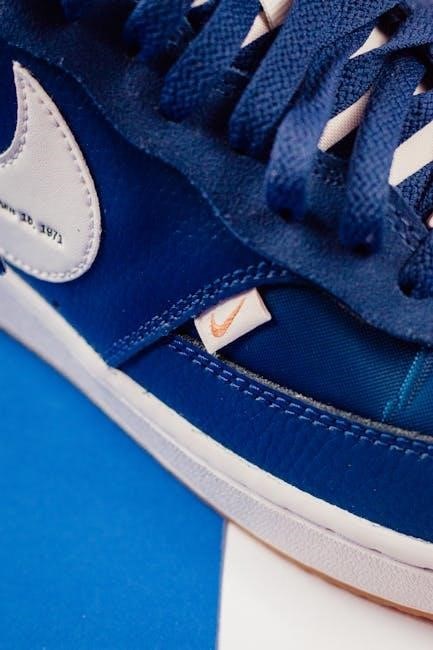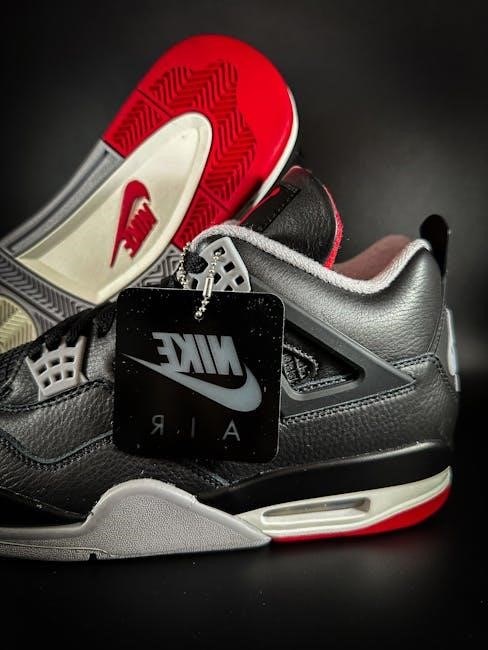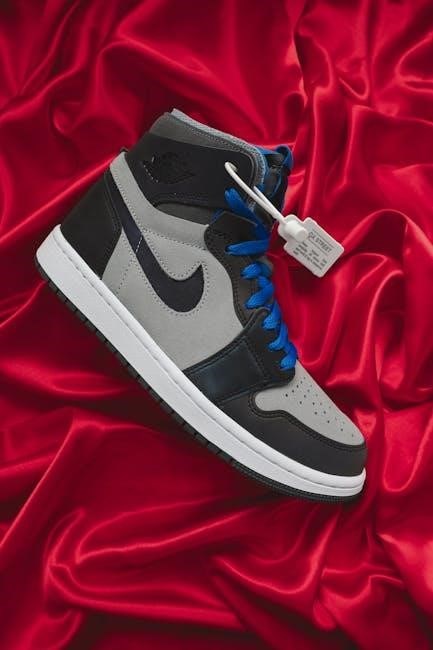Welcome to the ultimate guide to Nike tags! This comprehensive resource helps you identify authentic Nike products, understand their historical significance, and appreciate their design evolution over the years․
Understanding the Importance of Nike Tags
Nike tags are more than just labels; they hold crucial information about authenticity, quality, and product history․ These tags help consumers verify if a product is genuine, making them essential for avoiding counterfeits․ They also provide details like size, material, and production dates, ensuring transparency․ For collectors and enthusiasts, Nike tags offer insights into the brand’s evolution, with vintage labels becoming sought-after items․ Understanding these tags can enhance your shopping experience, helping you make informed decisions․ Whether you’re a casual buyer or a vintage collector, recognizing the significance of Nike tags is key to appreciating the brand’s legacy and ensuring you own authentic products․
Overview of Nike Tag Evolution
Nike tags have undergone significant changes since the brand’s inception, reflecting shifts in design, branding, and technology․ Early tags featured simple logos and minimal details, while modern tags include intricate designs and QR codes for authenticity verification․ The iconic “Swoosh” logo, introduced in 1971, has remained a constant element, evolving in style and placement․ Vintage tags from the 70s and 80s, such as the Orange Label, are now highly collectible․ Over the years, Nike has incorporated various materials and printing techniques, enhancing durability and visual appeal․ This evolution not only mirrors the brand’s growth but also adapts to consumer needs, ensuring tags remain both functional and aesthetically pleasing․

History of Nike Tags
Nike’s tag history began in 1964 with simple labels․ The iconic Swoosh debuted in 1971, evolving into detailed tags with logos, sizes, and production dates by the 1980s․
Vintage Nike Labels: A Historical Perspective
Vintage Nike labels offer a fascinating glimpse into the brand’s evolution․ The iconic Orange Label, used from 1978 to 1983, is a sought-after feature on vintage tees, sweatshirts, and shoes․ Its minimalistic design reflected Nike’s early focus on functionality and simplicity․ The Pinwheel Label, introduced in 1978, is another hallmark of vintage Nike apparel, appearing on jackets and footwear․ These labels were often made from softer, woven materials, differing from the modern tags․ Collectors prize vintage labels for their historical significance, as they provide insight into Nike’s design ethos during its formative years․ The tags not only authenticate items but also help date them, making them invaluable for enthusiasts of retro Nike gear․
Evolution of Nike Tag Design Over the Years
Nike tags have undergone significant transformations, reflecting the brand’s growth and design philosophy․ Early labels, like the Orange Label (1978-1983), were simple and functional, while the Pinwheel Label (1978) added a touch of creativity․ In the 1990s, tags began featuring the iconic “Just Do It” slogan, aligning with Nike’s bold marketing campaigns․ Modern tags incorporate sleek fonts, vibrant colors, and detailed product information, emphasizing authenticity and style․ Recent designs prioritize sustainability, using eco-friendly materials․ Each era’s tags tell a story of innovation, branding, and cultural impact, making them a key element in identifying Nike’s heritage and evolution over decades․

Types of Nike Tags
Nike tags vary, featuring authentic designs, vintage styles, and modern labels․ They include detailed product info, size codes, and logos, distinguishing genuine items from counterfeits with precision and clarity․
Authentic Nike Tags: Features and Designs
Authentic Nike tags are meticulously designed to ensure quality and legitimacy․ They often feature the iconic Nike swoosh logo, correct font styles, and precise color schemes․ These tags include details like size, style codes, and production dates, ensuring authenticity․ Vintage tags may display classic logos such as the “Orange Label” or “Pinwheel Label,” while modern tags incorporate advanced materials and holograms․ The stitching, alignment, and texture of authentic tags are consistent, with no signs of sloppy craftsmanship․ By examining these features, enthusiasts can distinguish genuine Nike products from counterfeits, ensuring their items are true to the brand’s heritage and quality standards․
Different Styles of Nike Labels (Vintage vs․ Modern)
Vintage Nike labels, such as the iconic “Orange Label” (1978-1983) and “Pinwheel Label” (1978-1982), showcase retro designs with bold colors and simpler graphics․ These labels often feature the Nike swoosh alongside minimal text, reflecting the brand’s early identity․ In contrast, modern labels incorporate sleek, high-tech designs with detailed information, including style codes, sizes, and production dates․ They may also use advanced materials and holograms for authenticity․ The evolution from vintage to modern labels highlights Nike’s growth and commitment to innovation while maintaining its recognizable brand aesthetic․ Understanding these differences aids collectors and enthusiasts in identifying and appreciating both eras of Nike’s rich history․
How to Authenticate Nike Tags
Authenticating Nike tags involves checking for correct fonts, precise sizing, and official style codes․ Compare tags to known authentic examples to ensure legitimacy and avoid counterfeit items․
Spotting Fake vs․ Real Nike Labels
Distinguishing fake from real Nike labels requires keen attention to detail․ Authentic tags typically feature crisp, precise fonts and consistent sizing, while counterfeit tags may have blurry text or uneven spacing․ The material quality is another key factor—genuine tags are made from durable, smooth textiles, whereas fake ones might feel cheap or rough․ Additionally, authentic Nike labels often include specific style codes and production dates that can be cross-referenced with official databases․ Always compare suspicious tags to verified examples, and be wary of missing or misaligned logos, such as the iconic Nike swoosh․ These subtle differences can make a significant difference in determining authenticity․
Key Details to Check for Authenticity
When verifying the authenticity of Nike tags, focus on specific details that set genuine products apart․ First, examine the style code, which should match the product’s official SKU․ Ensure the font is sharp and evenly sized, as counterfeit tags often have blurry or inconsistent text․ The tag’s material should feel sturdy and smooth, not flimsy or rough․ Check for the presence of a legitimate Nike swoosh logo, which should be perfectly aligned and proportionate․ Additionally, inspect the stitching around the tag—it should be tight and even․ For footwear, verify the size label behind the tongue, ensuring it includes accurate production dates and style codes․ These elements combined help confirm the tag’s legitimacy and the product’s authenticity․

Nike Tag Guide for Specific Products
This section explores Nike tags for specific products, detailing unique identifiers for vintage tees, sweatshirts, and footwear, ensuring accurate authentication through label and style code analysis․
Vintage Nike T-Shirts and Sweatshirts: Tag Identification
Identifying vintage Nike t-shirts and sweatshirts involves recognizing specific tags like the Orange Label (1978-1983) and Pinwheel Label (1978-1982)․ These labels, often found on tees, sweatshirts, and jackets, feature distinct designs and color schemes․ Authentic vintage tags typically exhibit sturdy materials and specific textures, with slight variations in font and logo design․ The Orange Label, for instance, has a unique shade and logo placement․ Additionally, checking the tag’s condition, such as signs of aging like fading or wear, can indicate authenticity․ The stitching around the tag and its placement, often inside the collar or on the hem, are also key factors․ Vintage logos may differ in swoosh design or font, reflecting earlier, simpler styles․ Color coding and historical production codes can further help date the item․ Consulting detailed guides or experts can provide precise insights, as they often have encountered various tags and can offer historical context based on their experience․ By systematically examining these elements—label type, material quality, design nuances, and historical coding—vintage Nike apparel can be accurately identified and authenticated․
Nike Footwear Tags: A Comprehensive Guide
Nike footwear tags are crucial for authenticity verification․ The box label typically features the style code (e․g․, CD4991-700), size, and production date․ The tongue tag displays size, country of manufacture, and material details․ Authentic tags have correct font, alignment, and color consistency․ The outsole often includes a herringbone pattern, and the insole may have a “Nike” logo․ Checking the box’s condition and comparing the tags to known authentic examples can help spot fakes․ The style code should match the product, and the production date should align with the shoe’s release․ Ensure all elements are present and properly printed․ These details collectively confirm the shoe’s authenticity and provide a reliable way to distinguish genuine Nike footwear from replicas․
Mastering Nike tag identification ensures authenticity, historical appreciation, and informed purchasing․ Use this guide to verify genuine Nike products and enjoy confident collecting and styling with trusted insights․
Final Tips for Identifying Authentic Nike Tags
To ensure authenticity, examine the tag’s font, size, and alignment carefully․ Genuine Nike tags feature consistent spacing and sharp, precise text․ Verify the style code format, ensuring it matches Nike’s standard (e․g․, CDXXXX-XXX); Compare the wash tag’s material and stitching with authenticated examples․ Check for subtle details like the Nike swoosh logo’s proper orientation and the presence of a secure QR code or UPC․ When in doubt, consult trusted platforms like StockX or The RealReal for verification․ Always prioritize purchasing from reputable sellers to avoid counterfeits․ By combining these methods, you can confidently authenticate Nike tags and build a trustworthy collection․



